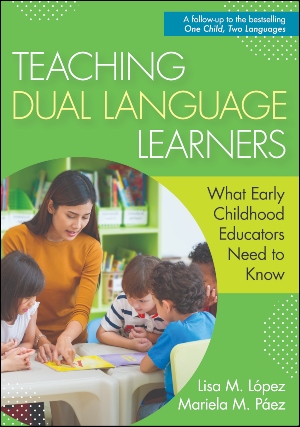Supporting Dual Language Learners During the Pandemic – Q&A with Lisa López and Mariela Páez



We asked Lisa López, Ph.D., and Mariela Páez, Ed.D., authors of the new Teaching Dual Language Learners: What Early Childhood Educators Need to Know, for their best advice on providing extra supports to young dual language learners during a time of prolonged learning disruptions.
Q: What are some unique challenges that young dual language learners are facing during this pandemic and how can early childhood educators help support them?
Dual language learners (DLLs) in the U.S. are facing unique challenges during this pandemic. With early childhood education (ECE) centers and schools closing during the pandemic, these children may be struggling with receiving the education necessary to continue thriving and to be successful once they return to school. Even if families of DLLs were provided access to distance learning, many of these families may have limited English language skills to support learning at home, may have limited familiarity with the technology being used, and/or may not have stable high-speed internet access. DLL families also tend to rely on ECE centers and schools for nutritious meals, a safe environment, in addition to social and cognitive development. Finally, many of our DLL families disproportionately represent essential workers, such that caregivers are still having to go to work and are at higher risk of becoming ill. These are all unique challenges that can lead to increase stress, anxiety, and concerns over health and safety within the home.
Therefore, it is more important than ever for early childhood educators to:
- Collect information about their DLL children and families including information about current challenges that they are facing during the pandemic and identify resources that might support them at school and at home.
- Recognize that DLL children may have increased risk for anxiety and can exhibit learning gaps due to the interruption in schooling. Many of these children may have lost access to reading, speech, behavior, physical, and occupational therapies which can further widen the learning gap. Early childhood educators will need to observe and assess where students are at developmentally so that they can appropriately plan and modify teaching.
- As DLL children return to the classroom it is important to adopt best practices for working with these children, including supporting oral language development, in their home language and in English, and providing them with developmentally, culturally, and linguistically appropriate trauma-informed services. In order to provide appropriate mental health services, it is important to have bilingual social workers, school psychologists, and guidance counselors on staff.
- If schools and ECE centers continue to be closed it is necessary to find unique ways to engage families and provide the families with practical strategies to help their children continue developing socially and cognitively. This can be done in the child’s home language through activities such as cooking, playing culturally appropriate games, going on nature walks, and through oral storytelling and retelling.

DLL children and their families are facing extraordinary challenges during these difficult times. Early childhood educators play a critical role in supporting these families and sustaining good practices which we know can have a positive impact in the lives of these children.
The Paraprofessional’s Handbook for Effective Support in Inclusive Classrooms
Second Edition
Extending the groundbreaking work of Patton O. Tabors and ideal for use as a textbook or in‐service guide, this concise book compiles everything teachers need to know about working with young DLLs—and setting them up for a lifetime of school success.
Additional resources:
5 Classroom Elements that Provide Opportunity for Dual Language Learners
See the elements »
5 Practical Strategies for Supporting Dual Language Learners’ Language and Literacy Skills
Read the tips »


